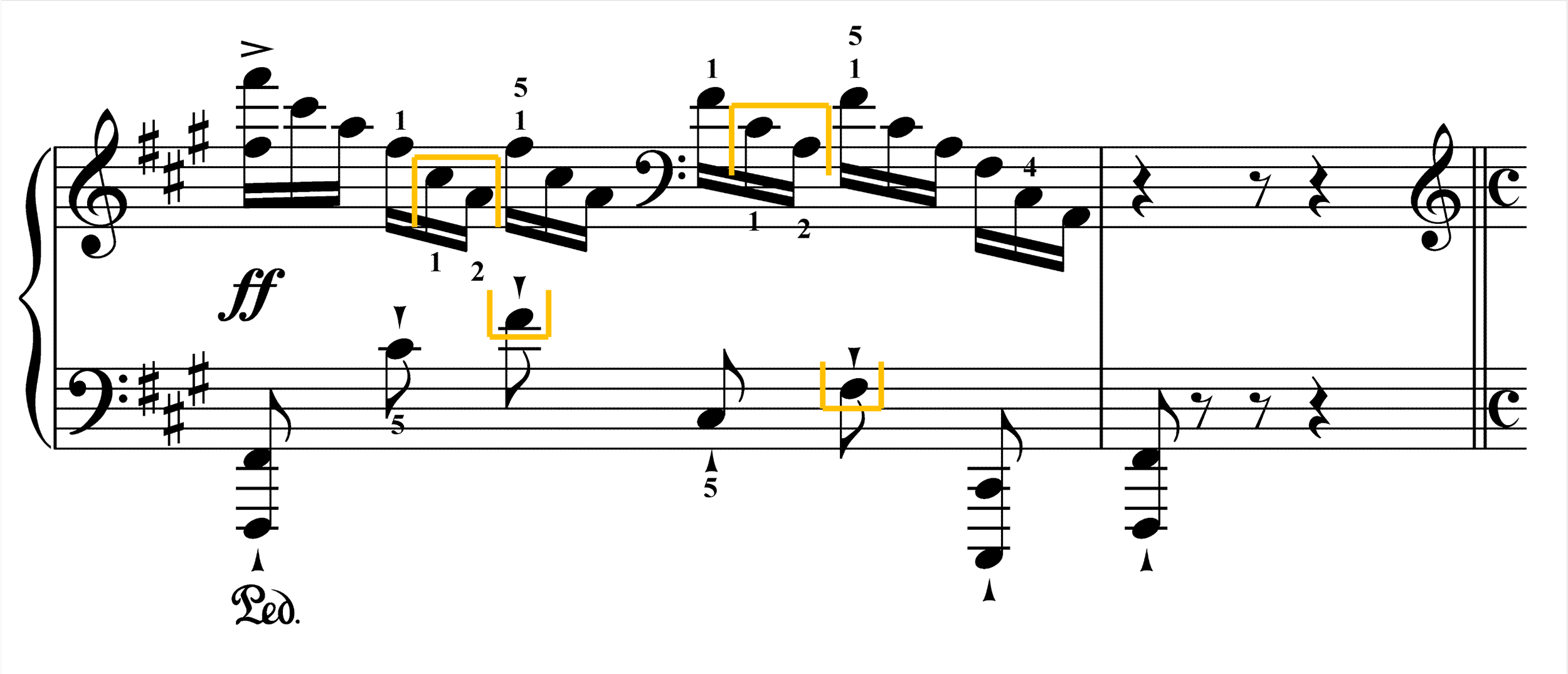Original:
Suggested performance:
“I find it easier to uncross the notes that overlap between the hands.”
Submitted by Michael Clark
Published on 1/1/2020
Original:

Suggested performance:

“I find it easier to uncross the notes that overlap between the hands.”
Submitted by Michael Clark
Published on 1/1/2020

“I find that taking the F-double sharp in the right hand is more reliable. My left hand can make the leap to D-sharp more accurately without worrying about getting to a white key after.”
Submitted by Michael Clark with thanks to Robert Roux
Published on 1/1/2020

“Using this fingering on the ascending arpeggio in the right hand leads smoothly into the octaves. On the descent, I prefer to start with an octave in the right hand so that the left hand can start with 1 on D.”
Submitted by Michael Clark
Published on 1/1/2020

“Taking the top note of the first few sixths in the right hand eliminates the large leap in the left hand. This redistribution feels much more secure to me.”
Submitted by Michael Clark
Published on 1/1/2020

“Starting with two hands helps me get this challenging movement off on the right foot. Taking the low F-sharp in m. 10 in the left hand gives more fingering flexibility for the repeated notes.”
Submitted by Michael Clark with thanks to Robert Roux
Published on 1/1/2020

“Taking the final C-sharp as an octave in the left hand gives the right hand extra time to move to the next position.”
Submitted by Michael Clark
Published on 1/3/2022

“The pedal is all the way down on this sudden fortissimo. There’s no reason not to get both hands involved.”
Submitted by Michael Clark
Published on 1/1/2020

“Taking the final G-sharps as an octave lets the left hand prepare for the next measure slightly earlier. Every little moment helps, and it’s easier to stagger the position shifts in the left and right hands.”
Submitted by Michael Clark
Published on 1/1/2020

“Ending the eighth-note run on finger 1 brings the right hand closer to the next position.”
Submitted by Michael Clark
Published on 1/3/2022

“I find this fingering more reliable and easier to control at this very soft dynamic and fast tempo.”
Submitted by Michael Clark
Published on 1/1/2020

“This fingering prioritizes a secure arrival on the final chord by placing 1 on the G two sixteenths earlier.”
Submitted by Michael Clark
Published on 1/3/2022

“Taking the arpeggio in the right hand after the third note facilitates a legato connection in the left hand.”
Submitted by Michael Clark
Published on 1/3/2022

“Taking the arpeggio in the right hand after the third note facilitates a legato connection in the left hand.”
Submitted by Michael Clark
Published on 1/3/2022

“This fingering reduces the number of position shifts in the right hand and allows the final D-sharp to be taken as an octave.”
Submitted by Michael Clark
Published on 1/3/2022

“Using 3-2-1 in both hands for each four-note group eliminates confusion and ensures a bold declamation.”
Submitted by Michael Clark with thanks to Robert Roux
Published on 1/3/2022

“With this redistribution, the pianist doesn't need to jump around or arpeggiate the right hand. Plus, playing the F-sharp octaves on the 3rd and 5th beats with the right hand provides emphasis to the strong beats of the fortissimo ending, creating a nice audible shape.”
Submitted by Kevin Lee Sun
Published on 1/28/2022

Submitted by Perry Zou
Published on 5/21/2025
“Redistributing the large chords in the RH to the left to increase accuracy and minimize unnecessary drag in tempo. Can be applied similarly in m. 120-125.”

Submitted by Perry Zou
Published on 5/21/2025
“A very small redistribution for easier execution (voicing the middle line shouldn’t be a problem with the change.”